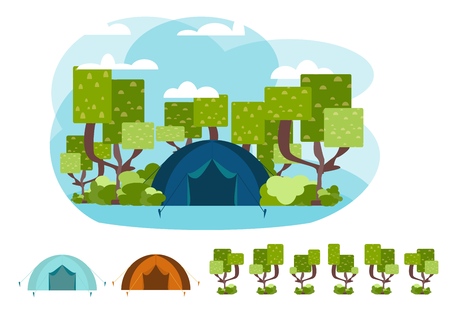1. Understanding Soil Health
Healthy soil is the foundation of any successful garden, farm, or ecosystem. In permaculture, we focus on regenerating and maintaining living soil that supports plant life, stores water efficiently, and cycles nutrients naturally. But what exactly makes soil healthy?
What Is Healthy Soil?
Healthy soil is more than just dirt—its a vibrant ecosystem filled with life. It has a balanced structure, high biodiversity, and strong capacity to retain moisture and nutrients. When these elements work together, plants grow better, pests are managed more naturally, and crops are more resilient.
Key Characteristics of Healthy Soil
| Characteristic | Description |
|---|---|
| Structure | Loamy texture with good balance of sand, silt, and clay; allows air and water to move freely. |
| Biodiversity | Rich in microorganisms like bacteria, fungi, earthworms, and insects that support nutrient cycling. |
| Water Retention | Holds moisture without becoming waterlogged; helps plants access water during dry periods. |
| Nutrient Availability | Contains essential minerals and organic matter that plants need to grow strong and healthy. |
Signs of Degraded Soil
Over time, soil can become degraded due to over-farming, chemical use, erosion, or lack of organic matter. Recognizing poor soil health early allows us to take steps toward regeneration.
Common Indicators of Poor Soil Health
- Hard, compacted ground thats difficult to dig into
- Poor drainage or standing water after rain
- Lack of earthworms or visible life in the soil
- Pale-colored soil lacking organic material
- Crops showing stunted growth or discoloration despite watering and fertilizing
Why Regeneration Matters
Soil regeneration is essential for long-term sustainability in agriculture and gardening. Without healthy soil, food production becomes harder and less reliable. By using permaculture principles—like composting, cover cropping, mulching, and minimizing tillage—we can bring life back into the soil while working with nature instead of against it.
A Living System Worth Protecting
The goal isn’t just to “fix” the soil but to create conditions where it thrives on its own. When we treat soil as a living system instead of an inert resource, we build resilience into our gardens and farms—and help heal the planet in the process.
2. Core Principles of Permaculture
Permaculture is more than a gardening method—its a way of thinking and designing that works with nature, not against it. When it comes to soil regeneration, permaculture offers a set of core principles that help us build healthy, living soil over time. These principles are grounded in three foundational ethics: Earth Care, People Care, and Fair Share.
Earth Care
This principle reminds us to respect and support the natural systems that sustain life. Healthy soil is the foundation of any thriving ecosystem. In permaculture, Earth Care means using methods that protect and enhance soil life—like composting, mulching, avoiding synthetic chemicals, and planting diverse crops. By nurturing the soil, we also help improve water retention, reduce erosion, and increase biodiversity.
People Care
Soil health directly affects human health. The food we grow depends on the quality of our soil. People Care encourages practices that keep communities strong and healthy by producing nutrient-rich food locally, reducing exposure to toxins, and involving people in sustainable land care activities. Community gardens and educational workshops are great ways to connect people to the land while regenerating the soil.
Fair Share
This ethic promotes sharing resources wisely and redistributing surplus to benefit everyone. In terms of soil regeneration, this could mean sharing compost materials with neighbors, passing on extra produce grown in healthy soil, or teaching others about regenerative practices. Its about creating a culture where we all contribute to and benefit from restored ecosystems.
How These Ethics Apply to Soil Regeneration
| PDC Ethic | Application to Soil Regeneration |
|---|---|
| Earth Care | Use composting, cover cropping, and no-till methods to build fertile soil. |
| People Care | Grow nutritious food locally; involve communities in soil-building efforts. |
| Fair Share | Share compost, tools, knowledge, and surplus harvests with others. |
Permaculture Design Principles That Support Soil Health
In addition to these ethics, permaculture includes specific design principles that guide how we interact with our environment. A few key ones related to soil regeneration include:
- Observe and Interact: Watch how your land behaves through the seasons before making changes.
- Catch and Store Energy: Build swales or use mulch to retain moisture in the soil.
- Use Small and Slow Solutions: Improve soil gradually through layered organic matter instead of quick fixes.
- Integrate Rather Than Segregate: Combine animals, plants, fungi, and microbes for a balanced soil ecosystem.
- Use and Value Diversity: Grow a mix of plants to support different types of soil organisms.
Together, these ethics and principles give us a clear path toward regenerating our soils in a sustainable way that benefits both people and planet.

3. Practical Techniques for Soil Regeneration
Regenerating soil through permaculture involves working with nature to rebuild healthy, living soil. Here are some hands-on techniques you can start using right in your backyard or homestead. These methods not only improve soil fertility but also boost microbial life and protect against erosion.
Composting
Composting is one of the simplest and most effective ways to return nutrients to the soil. By recycling kitchen scraps, yard waste, and other organic matter, you create a rich humus that feeds your plants and enhances soil structure.
Benefits of Composting
| What It Does | How It Helps Soil |
|---|---|
| Adds organic matter | Improves moisture retention and aeration |
| Feeds microbes | Boosts biodiversity in the soil food web |
| Recycles nutrients | Reduces need for chemical fertilizers |
Cover Cropping
Cover crops like clover, rye, or buckwheat are planted during off-seasons to protect and enrich the soil. These plants help fix nitrogen, prevent erosion, and break up compacted layers.
Common Cover Crops and Their Benefits
| Crop Type | Main Benefit |
|---|---|
| Clover | Nitrogen fixing for nutrient-rich soil |
| Rye | Erosion control and weed suppression |
| Buckwheat | Quick biomass production and pollinator support |
Mulching
Mulching involves covering the soil surface with organic materials like straw, wood chips, or leaves. This layer acts like a protective blanket that keeps moisture in, suppresses weeds, and gradually breaks down into nutrient-rich compost.
Why Mulching Matters
- Moisture Retention: Reduces water evaporation from the soil surface.
- Erosion Control: Protects topsoil from wind and rain damage.
- Nutrient Cycling: Adds slow-release nutrients as mulch decomposes.
No-Till Practices
No-till gardening avoids disturbing the soil structure by eliminating plowing or digging. This helps preserve beneficial fungi and bacteria that form symbiotic relationships with plant roots. Instead of tilling, you build new beds by layering compost, mulch, and organic matter directly on top of the existing ground—a method often called “sheet mulching” or “lasagna gardening.”
No-Till Benefits at a Glance:
- Healthier Soil Life: Leaves microbial habitats undisturbed.
- Less Erosion: Roots stay intact to hold soil in place.
- Saves Time & Energy: No heavy machinery or digging required.
Together, these techniques create a thriving ecosystem underground. By practicing composting, cover cropping, mulching, and no-till methods, youre not just growing better plants—youre building living soils that will sustain your garden for generations to come.
4. Using Native Plants and Biodiversity
One of the most effective ways to regenerate soil through permaculture is by using native plants and encouraging biodiversity in your garden or landscape. Native species are naturally adapted to local conditions like climate, rainfall, and soil type. This makes them easier to grow, less dependent on fertilizers or pesticides, and better for long-term soil health.
Why Choose Native Plants?
Native plants have evolved over time with the local ecosystem. They form symbiotic relationships with native insects, birds, fungi, and microorganisms. These connections support a healthier, more balanced environment above and below ground.
| Benefit | Description |
|---|---|
| Low Maintenance | Require less water, fertilizer, and chemical inputs |
| Soil Health | Deep root systems help prevent erosion and improve soil structure |
| Pest Resistance | Attract beneficial insects that control harmful pests naturally |
| Fungal Partnerships | Support mycorrhizal fungi which enhance nutrient uptake for plants |
The Role of Plant Diversity in Regenerative Systems
Diverse plantings mimic natural ecosystems and create a more resilient garden. Different plants bring different benefits to the soil—some fix nitrogen, others provide ground cover, and some attract pollinators or predatory insects.
Examples of Functional Plant Groups
| Plant Type | Function in Soil Regeneration |
|---|---|
| Legumes (e.g., clover, lupine) | Add nitrogen to the soil through root nodules |
| Deep-rooted plants (e.g., comfrey, yarrow) | Break up compacted soil and draw nutrients from deep layers |
| Ground covers (e.g., creeping thyme) | Reduce erosion and suppress weeds |
Supporting Beneficial Insects and Fungi
Diverse gardens with plenty of native flowers and shrubs attract pollinators like bees and butterflies, as well as predatory insects like ladybugs and lacewings that keep pest populations in check. At the same time, healthy plant communities support a thriving underground network of fungi that helps plants absorb nutrients more efficiently.
Tip:
Avoid using synthetic pesticides or herbicides that can harm beneficial insects and microbes. Instead, let nature do the work by creating an environment where these allies can thrive.
5. Creating Community and Long-Term Strategies
Soil regeneration through permaculture isnt just a personal journey—its a community effort. Building healthy, living soil requires collaboration, education, and long-term planning tailored to the unique needs of each region. Heres how you can engage your local community and develop sustainable strategies that last.
Engaging Local Communities
Getting neighbors, schools, local farmers, and organizations involved helps spread regenerative practices more effectively. Start small by hosting workshops or garden tours in your backyard or community space. Encourage people to share their successes and challenges. This builds a support system where everyone learns from one another.
Ways to Involve Your Community
| Activity | Description | Benefits |
|---|---|---|
| Community Garden Days | Invite locals to help build or maintain shared gardens | Hands-on learning, stronger community ties |
| Free Soil Health Workshops | Teach composting, mulching, and cover cropping techniques | Knowledge sharing, skill building |
| Local Seed Swaps | Exchange seeds adapted to your climate | Biodiversity, cost savings, cultural preservation |
| Youth Education Programs | Partner with schools for garden-based curriculum | Future generations learn early about soil care |
Sharing Knowledge Across Cultures and Climates
No two regions are alike—what works in Arizona might not work in Maine. Thats why its important to adapt regenerative practices to local conditions. Talk with indigenous communities, long-time residents, or regional extension services who understand the lands history and needs.
Tailoring Practices to Local Needs
- Drought-prone areas: Focus on water-harvesting systems like swales and mulch-heavy gardening.
- Cold climates: Use raised beds with compost insulation and cold frames.
- Tropical zones: Implement agroforestry and shade crops to protect the soil.
- Cultural traditions: Incorporate native planting methods passed down through generations.
The Power of Long-Term Thinking
Restoring soil health is not a quick fix—it’s a lifelong commitment. By thinking long-term, you shift from short-term yields to sustainable abundance. Plan for seasonal changes, future generations, and climate variability. Use crop rotations, perennial plants, and no-till methods that improve soil year after year.
Simple Steps for Long-Term Soil Regeneration
- Create a 3–5 year planting plan with diverse crops.
- Add organic matter regularly through composting or green manure.
- Avoid synthetic chemicals that damage soil microbes.
- Monitor progress with simple tests like earthworm counts or DIY soil jars.
- Keep learning—soil is alive, and so is our understanding of it!
The more we connect as a community and adapt our approaches over time, the more resilient our soils—and our food systems—will become.


